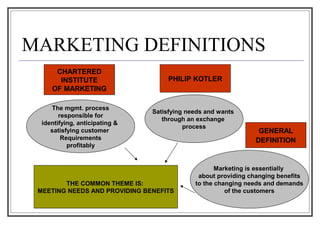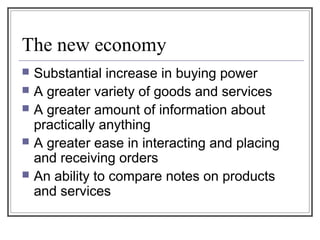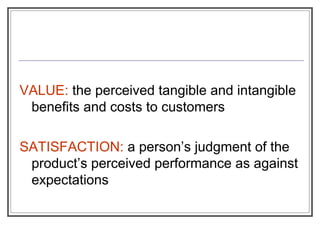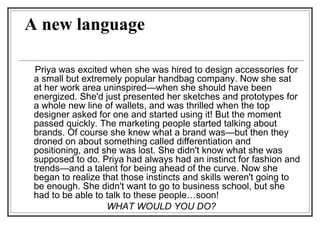Mkt1 (1)
- 1. MARKETING DEFINITIONS CHARTERED INSTITUTE OF MARKETING PHILIP KOTLER GENERAL DEFINITION The mgmt. process responsible for identifying, anticipating & satisfying customer Requirements profitably Satisfying needs and wants through an exchange process Marketing is essentially about providing changing benefits to the changing needs and demands of the customers THE COMMON THEME IS: MEETING NEEDS AND PROVIDING BENEFITS
- 3. American Marketing Assc. Marketing is the process of planning and executing the conception, pricing, promotion and distribution of ideas, goods, and services to create exchanges that satisfy individuals' and companies' goals.
- 4. Salient features of the definitions A main objective of marketing is to create customer value. Marketing usually involves an exchange between buyers and sellers or between other parties. Marketing has an impact on the firm, its suppliers, its customers, and others affected by the firm’s choices. Marketing frequently involves enduring relationships between buyers, sellers, and other parties. Processes involved include “creating, communicating, delivering, and exchanging offerings.”
- 5. Why marketing? Increasing Competition WTO, Globalization, Freer Exports and Imports Across Functions Finance Company, Computer Company etc Customer Focused From a Seller’s Market to a Buyer’s Market Ex: Bajaj
- 6. The new economy Substantial increase in buying power A greater variety of goods and services A greater amount of information about practically anything A greater ease in interacting and placing and receiving orders An ability to compare notes on products and services
- 7. Concepts in Marketing • The Production Concept : States that Consumers will favor those products that are widely available and low in cost • Therefore what do you do? • Any companies following this concept today?
- 8. Production concept Produce as much as possible • Distribute widely • Example, Henry Ford’s early cars • Today, screws, nuts, plugs • However, there were problems here, which were? • No focus on quality and features, just price and availability
- 9. This paved way to the “Product Concept” Product Concept: Consumers will favour that product that offers the best quality/performance and most features • Hence, what do you do? • Make the “best” possible product • Do R&D, come out with new features, improve, improve and improve • What are the problems here?
- 10. Product Concept - Myopia Ted Levitt called it “Marketing Myopia” • Focus on the consumer need, rather than on the product • For instance, railroad companies in the US • The rise of budget airlines, even in Asia • Bajaj missed the motorcycle revolution • IBM missed the PC revolution
- 11. Marketing concept Marketing Concept: Determine Consumer Needs/Wants and fill them better than anyone else, at a profit • The Consumer is thus the starting point • Marketing starts with consumer needs • Hence, marketers have to be consumer focused always, consumer obsessed, in fact • Who is the market leader in consumer electronics today? • So is this the end or can we improve the marketing concept any further? • Is the customer the only person you care about?
- 12. You need to care about society as well ….
- 13. Societal marketing concept Societal Marketing: Fulfill consumer needs, at the same time, don’t harm him/her & society • Thus, McDonalds faced lawsuits • Eco-friendliness is in vogue - CFC free fridges the norm • Thus, currently, the last two concepts hold sway
- 14. Marketing starts with the organization's mission: How does it define itself? What are its goals? Who are its customers? How does it intend to fulfill its mission?
- 16. Marketing Orientation? who the company's customers are what the company's customers want or need how the firm can satisfy those customer needs better than its rivals how the firm can satisfy customer needs in a way that generates the kind of profits that the company wants to achieve
- 17. Understand what the customer wants…
- 18. NEEDS / WANTS / DEMAND Needs are the basic human requirements Wants are directed to specific objects that satisfy the need Demands and wants are backed by the “ability” to buy/pay
- 19. Marketing focuses on customer needs stated needs—what customers say they want real needs—what customers actually require unstated needs—requirements that customers don't happen to mention delight needs—the desire for luxuries, as compared to real needs secret needs—needs that customers feel reluctant to admit
- 20. Match companies offerings to customer needs…
- 21. Companies can offer – Goods Services Experiences Events persons Places Properties Organisation Information Ideas
- 22. Demand states (courtesy: Philip Kotler, Marketing Management) Negative Demand The market is in a state of negative demand if; a major part of the market dislikes the product and may even pay a price to avoid it. Eg: People have a negative demand for Vaccination Dental work Vasectomies Gall bladder operation Employers feel a negative demand for Ex-convicts Alcoholics
- 23. No Demand Target consumers may be uninterested in the product. Ex – People have no demand for Farmers may not be interested in new farming methods College students may not be interested in a foreign language course.
- 24. Latent Demand: Many consumers may share a strong need that cannot be satisfied by any existing products. Latent demand for harmless cigarettes. Safer neighborhood. More fuel efficient cars. The marketing task is to measure the size of the potential market and develop effective goods and services that would satisfy the demand.
- 25. Declining Demand A substantial drop in the demand for products. Boy scout enrolment among Singapore students. The marketing task is to: Analyse the cause of market decline. Determine whether the demand can be re-stimulated by changing target markets, changing product features and developing more effective goods. To reverse the declining demand through creative remarketing of the product.
- 26. Irregular Demand Organizations face demand that varies on a seasonal, daily or even hourly basis, causing problems of idle capacity or overcrowded capacity. Markets :- visited on weekends, not on weekdays. Hospitals :- OT’s booked for early weak The marketing task is called Synchro Marketing (alter pricing, promotion & other incentives)
- 27. Full Demand Organizations face full demand when they are pleased with their volume of business. The marketing task is to: Maintain the current level of demand in the face of changing consumer preferences and increasing competition. Quality should be improved. Continuously measure consumer satisfaction. Eg: Maruti at the time of bookings made open.
- 28. Overfull Demand Some organizations face a demand level that is higher than they can or want to handle. Marketing task is De-marketing which requires finding ways to reduce the demand temporarily or permanently. Steps involved in de-marketing: Raising prices. Reducing promotion and service. Selective de-marketing(less profitable markets)
- 29. Unwholesome Demand Unwholesome products will attract organized effort to discourage their consumption. Un-selling campaigns have been conducted against cigarettes alcohol hard drugs handguns pirated movies
- 30. Can you name a category of products forCan you name a category of products for which your negative feelings havewhich your negative feelings have softened? What precipitatedsoftened? What precipitated this change?this change?
- 31. SEGMENTING TARGET MARKETS MARKET OFFERINGS ITS POSITION IN THE MIND OF THE BUYERS
- 32. OFFERINGS The intangible value proposition (a set of benefits offered to customers to satisfy their needs) is made physical by an “offering” BRANDS It is an offering from a known source - A name, term, sign, symbol or design or a combination of these intended to identify the goods of one seller and to differentiate it from those of competitors
- 33. VALUE: the perceived tangible and intangible benefits and costs to customers SATISFACTION: a person’s judgment of the product’s perceived performance as against expectations
- 35.
- 37. A new language Priya was excited when she was hired to design accessories for a small but extremely popular handbag company. Now she sat at her work area uninspired—when she should have been energized. She'd just presented her sketches and prototypes for a whole new line of wallets, and was thrilled when the top designer asked for one and started using it! But the moment passed quickly. The marketing people started talking about brands. Of course she knew what a brand was—but then they droned on about something called differentiation and positioning, and she was lost. She didn't know what she was supposed to do. Priya had always had an instinct for fashion and trends—and a talent for being ahead of the curve. Now she began to realize that those instincts and skills weren't going to be enough. She didn't want to go to business school, but she had to be able to talk to these people…soon! WHAT WOULD YOU DO?
- 38. Building the business Well-Built Furniture had a banner year selling attractive home-office furniture to customers in a large metropolitan area. At a monthl executive meeting, sales rep Harry presented his idea to develop a new service: For an additional cost, customers could have a Well- Built service representative assemble the unit in their home. Harry had talked to enough customers to know the service would be a huge success. Every customer he talked to loved the idea. Harry started planning right away. He was projecting the costs of training the reps when a guy from marketing strolled up to his desk and started asking about what the competition was doing. Then he asked if Harry could come up with numbers to show how the added service would increase revenue…and, more importantly, raise profits. Harry was tempted to ask, "Isn't that you job?" but he'd been around long enough to know you don't talk to other managers that way. Besides, the questions made him a little nervous. What if the idea wasn't as profitable as he'd thought? Maybe he was rushing into it. Maybe he should come up with some numbers, but how? He didn't even know where to begin. What would YOU do?
- 39. ANSOFF MATRIX MARKET PENETRATION increasing sales of an existing product and penetrating the market further by either promoting the product heavily or reducing prices PRODUCT DEVELOPMENT Developing new products aimed within existing market, in the hope of gaining more customers / market share. MARKET DEVELOPMENT Strategy of selling existing products to new markets – thru’ segmentation or new overseas markets DIVERSIFICATION Moving away from the core activities to providing something new CONSOLIDATION Strategy of withdrawing from particular markets, scaling down on operations and concentrating on existing products in existing markets Current NewPRODUCT Current New MARKET
- 40. MARKETING BLUNDERS!!!! Scandinavian vacuum manufacturer Electrolux used the following in an American campaign: "Nothing sucks like an Electrolux." Coors put its slogan, "Turn It Loose," into Spanish where its translation was read as "Suffer From Diarrhea." Clairol introduced the "Mist Stick", a curling iron, into German only to find out that "mist" is slang for manure. Not too many people had use for the "manure stick."








































